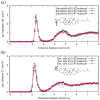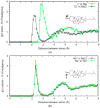Specific Ion Effects in Cholesterol Monolayers
- PMID: 28773463
- PMCID: PMC5503052
- DOI: 10.3390/ma9050340
Specific Ion Effects in Cholesterol Monolayers
Abstract
The interaction of ions with interfaces and, in particular, the high specificity of these interactions to the particular ions considered, are central questions in the field of surface forces. Here we study the effect of different salts (NaI, NaCl, CaCl₂ and MgCl₂) on monolayers made of cholesterol molecules, both experimentally (surface area vs. lateral pressure isotherms measured by a Langmuir Film Balance) and theoretically (molecular dynamics (MD) all-atomic simulations). We found that surface isotherms depend, both quantitatively and qualitatively, on the nature of the ions by altering the shape and features of the isotherm. In line with the experiments, MD simulations show clear evidences of specific ionic effects and also provide molecular level details on ion specific interactions with cholesterol. More importantly, MD simulations show that the interaction of a particular ion with the surface depends strongly on its counterion, a feature ignored so far in most theories of specific ionic effects in surface forces.
Keywords: Langmuir monolayers; cholesterol; ionic specificity; molecular dynamics simulations; surface forces.
Conflict of interest statement
The authors declare no conflict of interest.
Figures








Similar articles
-
Electrolytes in a nanometer slab-confinement: ion-specific structure and solvation forces.J Chem Phys. 2010 Oct 28;133(16):164511. doi: 10.1063/1.3490666. J Chem Phys. 2010. PMID: 21033809
-
Ionic Liquid Films at the Water-Air Interface: Langmuir Isotherms of Tetra-alkylphosphonium-Based Ionic Liquids.Langmuir. 2015 Aug 4;31(30):8371-8. doi: 10.1021/acs.langmuir.5b01977. Epub 2015 Jul 23. Langmuir. 2015. PMID: 26161843
-
A Langmuir film balance study of the interactions of ionic and polar solutes with glycolipid monolayers.Biochim Biophys Acta. 1985 May 28;815(3):325-33. doi: 10.1016/0005-2736(85)90358-x. Biochim Biophys Acta. 1985. PMID: 3995031
-
Specific ion adsorption and surface forces in colloid science.J Phys Chem B. 2008 Feb 14;112(6):1580-5. doi: 10.1021/jp7098174. Epub 2008 Jan 19. J Phys Chem B. 2008. PMID: 18205350
-
Separating viscoelastic and compressibility contributions in pressure-area isotherm measurements.Adv Colloid Interface Sci. 2014 Apr;206:428-36. doi: 10.1016/j.cis.2013.09.005. Epub 2013 Sep 29. Adv Colloid Interface Sci. 2014. PMID: 24103106 Review.
Cited by
-
The role of structural order in heterogeneous ice nucleation.Chem Sci. 2022 Apr 8;13(17):5014-5026. doi: 10.1039/d1sc06338c. eCollection 2022 May 4. Chem Sci. 2022. PMID: 35655890 Free PMC article.
-
Design of Therapeutic Self-Assembled Monolayers of Thiolated Abiraterone.Nanomaterials (Basel). 2018 Dec 7;8(12):1018. doi: 10.3390/nano8121018. Nanomaterials (Basel). 2018. PMID: 30544493 Free PMC article.
-
Cholesterol Alters the Phase Separation in Model Membranes Containing hBest1.Molecules. 2022 Jul 2;27(13):4267. doi: 10.3390/molecules27134267. Molecules. 2022. PMID: 35807512 Free PMC article.
-
Condensing Effect of Cholesterol on hBest1/POPC and hBest1/SM Langmuir Monolayers.Membranes (Basel). 2021 Jan 13;11(1):52. doi: 10.3390/membranes11010052. Membranes (Basel). 2021. PMID: 33451008 Free PMC article.
References
-
- Evans D.F., Wennerström H. The Colloidal Domain: Where Physics, Chemistry, Biology, and Technology Meet. VCH Publishers; New York, NY, USA: 1999.
-
- Kunz W. Specific ion effects in colloidal and biological systems. Curr. Opin. Colloid Interface Sci. 2010;15:34–39. doi: 10.1016/j.cocis.2009.11.008. - DOI
-
- Marcus Y. Ions in Water and Biophysical Implications: From Chaos to Cosmos. Springer; Dordrecht, The Netherlands: 2012.
-
- Alberts B. Molecular Biology of the Cell. Garland Science; New York, NY, USA: 2015.
LinkOut - more resources
Full Text Sources
Other Literature Sources

